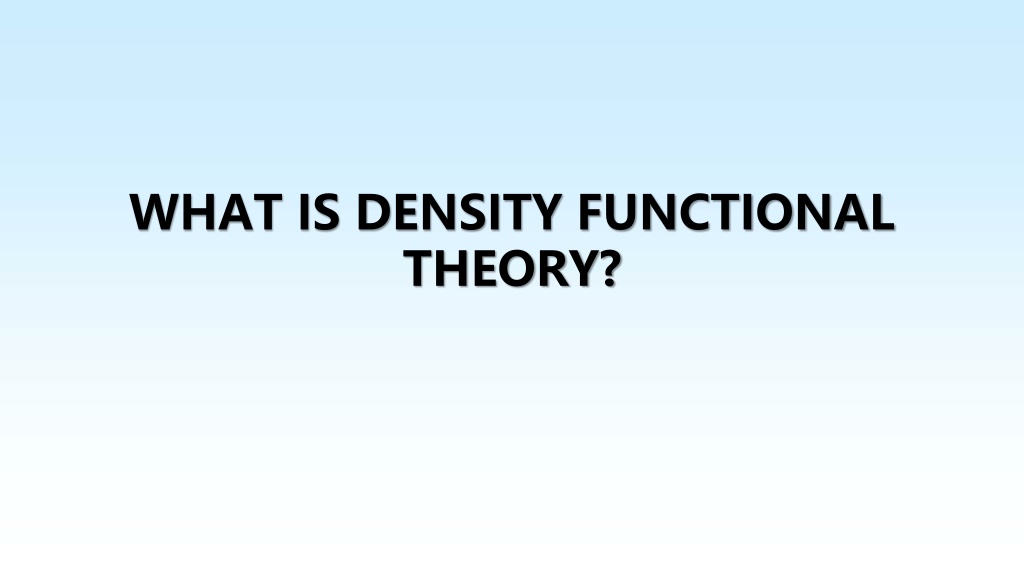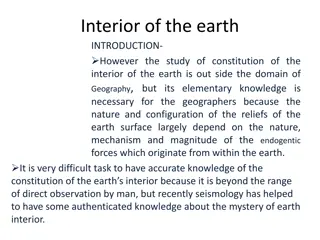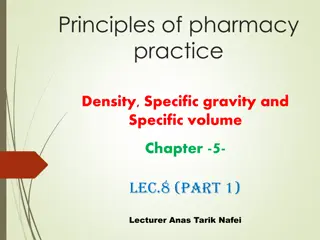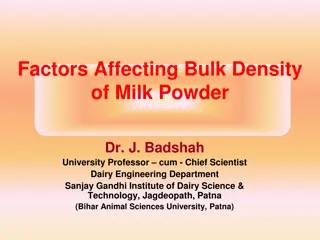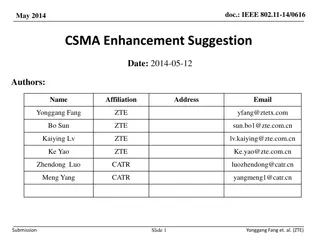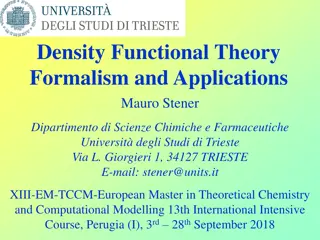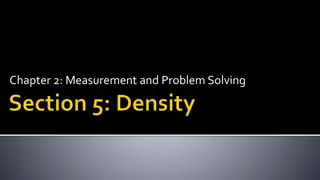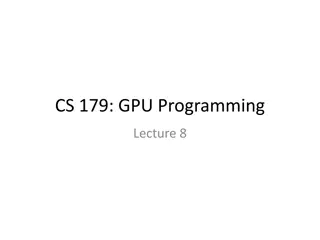Applications of Density Functional Theory (DFT) in Various Fields
Density Functional Theory (DFT) is a powerful computational tool used in various scientific fields to understand complex chemical and physical phenomena. This theory allows for detailed analysis and prediction of material properties, reactions, and structures at the atomic level. Through the examples of ammonia synthesis, embrittlement of metals, and modeling planetary materials, the significance and versatility of DFT calculations are demonstrated. Researchers utilize DFT to study catalyst activities, material embrittlement mechanisms, and extreme conditions inside planets, providing valuable insights into fundamental processes.
Download Presentation

Please find below an Image/Link to download the presentation.
The content on the website is provided AS IS for your information and personal use only. It may not be sold, licensed, or shared on other websites without obtaining consent from the author. Download presentation by click this link. If you encounter any issues during the download, it is possible that the publisher has removed the file from their server.
E N D
Presentation Transcript
WHAT IS DENSITY FUNCTIONAL THEORY?
1.1 EXAMPLES OF DFT IN ACTION 1.1.1 Ammonia Synthesis by Heterogeneous Catalysis The core reaction in ammonia production is very simple: N2+3H2 2NH3 Can a direct connection be made between the shape and size of a metal nanoparticle and its activity as a catalyst for ammonia synthesis? 2
Honkala and co-workers, using DFT calculations, showed that the net chemical reaction above proceeds via at least 12 distinct steps on a metal catalyst and that the rates of these steps depend strongly on the local coordination of the metal atoms that are involved. One of the most important reactions is the breaking of the N2bond on the catalyst surface. On regions of the catalyst surface that were similar to the surfaces of bulk Ru (more specifically, atomically flat regions),a great deal of energy is required for this bond-breaking reaction. 3
1.1.2 Embrittlement of Metals by Trace Impurities It has been known for over 100 years that adding tiny amounts of certain impurities to copper can change the metal from being ductile to a material that will fracture in a brittle way. This occurs, for example, when bismuth (Bi) is present in copper(Cu) at levels below 100 ppm. Can the changes in copper caused by Bi be explained in a detailed way? 4
Schweinfest, Paxton, and Finnis used DFT calculations to offer a definitive description of how Bi embrittles copper. They first used DFT to predict stress strain relationships for pure Cu and Cu containing Bi atoms as impurities. They explicitly calculated the cohesion energy of a particular grain boundary that is known embrittled by Bi. experimentally to be 5
1.1.3 Materials Properties for Modeling Planetary Formation The extreme conditions that exist inside planets pose some obvious challenges to probing these topics in laboratory experiments. DFT calculations can play a useful role in probing material properties at these extreme conditions. 6
Umemoto et al. wanted to understand what happens to the structure of MgSiO3at conditions much more extreme than those found in Earth s core mantle boundary. These calculations predicted that at pressures of ~11 Mbar, MgSiO3dissociates in the following way: MgSiO3[CaIrO3structure] MgO [CsCl structure] + SiO2[cotunnite structure]. 7
These transformations in the structures of MgO and SiO2 allow an important connection to be made between DFT calculations and experiments since these transformations occur at conditions that can be directly probed in laboratory experiments. The observed experimentally are in good agreement, giving a strong indication of the accuracy of these calculations. transition pressures predicted using DFT and 8
1.2 THE SCHRDINGER EQUATION Since the mass of the nucleus is much larger than the mass of the electron, the response of electrons to environmental changes is much faster than that of nucleus. As a result, we can split our physical question into two pieces. First, we solve, for fixed positions of the atomic nuclei, the equations that describe the electron motion. For a given set of electrons moving in the field of a set of nuclei, we find the lowest energy configuration, or state, of the electrons. 9
If we have M nuclei at positions R1, . . . , RM, we can express the ground-state energy, E, as a function of the positions of these nuclei, E(R1, . . . , RM) we are able to calculate this potential energy surface we can tackle the original problem posed above how does the energy of the material change as we move its atoms around? 10
Schrdinger equation under the interaction system of multiple electrons and polyatomic nucleus Here, m is the electron mass. For the Hamiltonian we have chosen, c is the electronic wave function, which is a function of each of the spatial coordinates of each of the N electrons, so c c(r1, . . . , rN), and E is the groundstate energy of the electrons. 11
The quantity of physical interest is really the probability that a set of N electrons in any order have coordinates r1, . . .rN. A closely related quantity is the density of electrons at a particular position in space, n(r). This can be written in terms of the individual electron wave functions as The point of this discussion is that the electron density, n(r) contains a great amount of the information that is actually physically observable from the full wave function solution to the Schr dinger equation. 12
1.3 DENSITY FUNCTIONAL THEORYFROM WAVE FUNCTIONS TO ELECTRON DENSITY The entire field of density functional theory rests on two fundamental mathematical theorems proved by Kohn and Hohenberg and the derivation of a set of equations by Kohn and Sham. The first theorem is: The ground-state energy from Schr dinger s equation is a unique functional of the electron density. 13
This theorem states that there exists a one-to-one mapping between the ground-state wave function and the ground- state electron density. we can restate Hohenberg and Kohn s result by saying that the ground-state energy E can be expressed as E[n(r)], where n(r) is the electron density. Another way to restate Hohenberg and Kohn s result is that the ground-state electron density uniquely determines all properties, including the energy and wave function, of the ground state. 14
Why is this result important? It means that we can think about solving the Schr dinger equation by finding a function of three spatial variables, the electron density, rather than a function of 3N variables, the wave function. 15
The second HohenbergKohn theorem defines an important property of the functional: The electron density that minimizes the energy of the overall functional is the true electron density corresponding to the full solution of the Schr dinger equation. 16
The energy functional can be written as Where we have split the functional into a collection of terms we can write down in a simple analytical form, Eknown[{ i}], and everything else, EXC. The known terms include four contributions: 17
The terms on the right are, in order, the electron kinetic energies, the Coulomb interactions between the electrons and the nuclei, the Coulomb interactions between pairs of electrons, and the Coulomb interactions between pairs of Nuclei. The other term in the complete energy functional, EXC[{ i}], is the exchange correlation functional, and it is defined to include all the quantum mechanical effects that are not included in the known terms. 18
Let us imagine for now that we can express the as-yet- undefined exchange correlation energy functional in some useful way. What is involved in finding minimum energy solutions of the total energy functional? This difficulty was solved by Kohn and Sham, who showed that the task of finding the right electron density can be expressed in a way that involves solving a set of equations in which each equation only involves a single electron. 19
The KohnSham equations have the form On the left-hand side of the Kohn Sham equations there are three potentials, V, VH, and VXC. 20
V The first of these also appeared in the full Schr dinger equation and in the known part of the total energy functional given above. This potential defines the interaction between an electron and the collection of atomic nuclei. 21
VH The second is called the Hartree potential and is defined by The Hartree potential includes a socalled self-interaction contribution because the electron we are describing in the Kohn Sham equation is also part of the total electron density, so part of VH involves a Coulomb interaction between the electron and itself. 22
VXCcan formally be defined as a functional derivative of the exchange correlation energy: 23
If you have a vague sense that there is something circular about our discussion of the Kohn Sham equations you are exactly right. To break this circle, the problem is usually treated in an iterative way as outlined algorithm: in the following 24
1. Define an initial, trial electron density, n(r). 2. Solve the Kohn Sham equations defined using the trial electron density to find the single-particle wave functions, i(r). 3. Calculate the electron density defined by the Kohn Sham singleparticle wave functions from step 2, nKS(r) = 2 ??? (r)??(r). 25
4. Compare the calculated electron density, nKS(r), with the electron density used in solving the Kohn Sham equations, n(r). If the two densities are the same, then this is the ground-state electron density, and it can be used to compute the total energy. If the two densities are different, then the trial electron density must be updated in some way. Once this is done, the process begins again from step 2. 26
1.4 EXCHANGECORRELATION FUNCTIONAL Local Density Approximation , LDA we set the exchange correlation potential at each position to be the known exchange correlation potential from the uniform electron gas at the electron density observed at that position: This approximation uses only the local density to define the approximate exchange correlation functional. 27
The LDA gives us a way to completely define the Kohn Sham equations, but it is crucial to remember that the results from these equations do not exactly solve the true Schr dinger equation because we are not using the true exchange correlation functional. 28
It should not surprise you that the LDA is not the only functional that has been tried within DFT calculations. The development of functionals that more faithfully represent nature remains one of the most important areas of active research in the quantum chemistry community. 29
Generalized Gradient Approximation , GGA Two of the most widely used functionals in calculations involving solids are the Perdew Wang functional (PW91) and the Perdew Burke Ernzerhof functional (PBE). Each of these functionals are GGA functionals, and dozens of other GGA functionals have been particularly for calculations with isolated molecules. developed and used, 30
1.5 THE QUANTUM CHEMISTRY TOURIST As you read about the approaches aside from DFT that exist for finding numerical solutions equation, it is likely that you will rapidly encounter a bewildering array of acronyms. This section aims to present an overview of quantum chemical methods on the level of a phrase book or travel guide. of the Schr dinger 31
1.5.1 Localized and Spatially Extended Functions As an example of a spatially localized function, Fig. 1.1 shows the function 32
We could include more information in this final function by including more individual functions within its definition. Also, we could build up functions that describe multiple atoms simply by using an appropriate set of localized functions for each individual atom. 34
What if we are interested in a bulk material such as the atoms in solid silicon or the atoms beneath the surface of a metal catalyst? A useful alternative is to use periodic functions to describe the wave functions or electron densities. 35
Figure 1.2 shows a simple example of this idea by plotting: The resulting function is periodic; that is 37
1.5.2 HartreeFock Method Suppose we would like to approximate the wave function of N electrons. Let us assume for the moment that the electrons have no effect on each other. If this is true, the Hamiltonian for the electrons may be written as where hidescribes the kinetic and potential energy of electron i. 38
If we write down the Schrdinger equation for just one electron based on this Hamiltonian, the solutions would satisfy : The eigenfunctions defined by this equation are called spin orbitals. 39
When the total Hamiltonian is simply a sum of one-electron operators, hi, it follows that the eigenfunctions of H are products of the one-electron spin orbitals: The energy of this wave function is the sum of the spin orbital energies, E = Ej1+ +EjN. 40
Electrons are fermions, the wave function must change sign if two electrons change places with each other. Exchanging two electrons does not change the sign of the Hartree product, which is a serious drawback. We can obtain a better approximation to the wave function by using a Slater determinant. 41
For two electrons, the Slater determinant is The coefficient of (1/ 2) is simply a normalization factor. 42
In a HartreeFock (HF) calculation, we fix the positions of the atomic nuclei and aim to determine the wave function of N-interacting electrons. The Schr dinger equation for each electron is written as 43
How to express the solution of the above single electron equation? How do you combine these solutions into N electron wave functions? 44
To do this, we define a finite set of functions that can be added together to approximate the exact spin orbitals. If our finite set of functions is written as 1(x), 2(x), , K(x), then we can approximate the spin orbitals as: 45
When using this expression, we only need to find the expansion coefficients, aj,i, for i 1, . . . , K and j 1, . . . , N to fully define all the spin orbitals that are used in the HF method. The set of functions 1(x), 2(x), . . . , K(x) is called the basis set for the calculation. 46
Like solving the Kohn-Sham equation, an HF calculation is an iterative procedure that can be outlined as follows: 1. Make an initial estimate of the spin orbitals by specifying the expansion coefficients, aj,i. 2. From the current estimate of the spin orbitals, define the electron density, n(r`): 3. Using the electron density from step 2, solve the single- electron equations for the spin orbitals. 47
4. If the spin orbitals found in step 3 are consistent with orbitals used in step 2, then these are the solutions to the HF problem we set out to calculate. If not, then a new estimate for the spin orbitals must be made and we then return to step 2. 48
1.5.4 Beyond HartreeFock How do more advanced quantum chemical approaches improve on the HF method? The approaches vary, but the common goal is to include a description Methods based on a single reference determinant are formally known as methods. of electron correlation. post Hartree Fock 49
The classification of wave-function-based methods has two distinct components: the level of theory and the basis set. To illustrate the role of the level of theory and the basis set, we will look at two properties of a molecule of CH4, the C H bond length and the ionization energy. Experimentally, the C H bond length is 1.094A and the ionization energy for methane is 12.61 eV. 50
